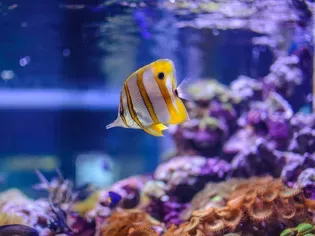Complete Aquarium Checklist for Beginners
Updated on 04/26/24

Dive into Aquascaping: The Ultimate Aquarium Checklist for Beginners
Welcome to the enthralling world of aquascaping, where imagination meets tranquility. Whether you're a seasoned hobbyist or just starting your aquatic journey, this comprehensive checklist will guide you every step of the way, ensuring a thriving ecosystem and captivating visuals.
1. Aquariums: Your Aquatic Landscape
- Choose the right size: Consider the number and size of fish you intend to keep.
- Think about the shape: Rectangular, hexagonal, or even custom-designed aquariums can enhance the visual appeal.
- Material matters: Opt for durable materials like glass or acrylic that can withstand water pressure and provide optimal visibility.
2. Filtration: The Lifeline of Your Aquarium
- Mechanical filters: Capture debris and sediment, keeping water crystal clear.
- Biological filters: House beneficial bacteria that convert ammonia and nitrite into less harmful nitrates.
- Chemical filters: Remove dissolved impurities and discoloration, enhancing water quality.
3. Lighting: Illuminating the Underwater World
- Determine the light intensity: Different plants and fish have specific lighting requirements.
- Choose the right spectrum: Full-spectrum lights provide balanced illumination, while specific wavelengths can enhance plant growth.
- Set up a timer: Regulate the photoperiod to replicate natural daylight cycles.
4. Circulation: Ensuring Constant Water Flow
- Pumps: Create water movement, providing oxygen and distributing nutrients throughout the aquarium.
- Diffusers: Release dissolved oxygen through tiny air bubbles, ensuring proper aeration.
- Powerheads: Direct water flow to specific areas, creating currents for a more dynamic environment.
5. Substrate: Laying the Foundation
- Sand: Inert and easy to maintain, suitable for bottom-dwelling fish.
- Gravel: Provides a natural habitat and aids in filtration.
- Soil: Rich in nutrients, ideal for heavily planted tanks.
6. Plants: The Natural Decorators
- Live plants: Oxygen producers, nutrient absorbers, and hiding places for fish.
- Choose hardy species: Beginners should start with adaptable plants like Anubias or Java Fern.
- Planted tank layout: Position plants strategically to create visual interest and provide cover for wildlife.
7. Hardscape: Creating Naturalistic Elements
- Rocks and driftwood: Provide shelter and mimic natural habitats.
- Arrange rocks: Build caves, slopes, and other structures to create depth and interest.
- Use driftwood: Add texture and color to the tank while providing hiding spots for fish.
8. Fish: The Stars of the Show
- Research species: Compatibility, size, and temperament should all be considered.
- Start with hardy fish: Beginners may want to opt for beginner-friendly species like guppies or tetras.
- Acclimate carefully: Avoid introducing shock by gradually adjusting the temperature and water parameters of the new aquarium.
9. Monitoring and Maintenance
- Water testing: Regularly check for pH, ammonia, nitrite, and nitrate levels to ensure optimal water quality.
- Water changes: Perform partial water changes regularly to remove waste and replenish minerals.
- Tank cleaning: Vacuum the substrate, clean the filters, and wipe down the glass to keep the aquarium pristine.
10. Additional Equipment
- Heater: Maintain a stable water temperature for tropical species.
- Thermometer: Monitor water temperature to prevent overheating or underheating.
- Algae scraper: Remove unsightly algae from aquarium surfaces.
- Net: Safely transfer fish during maintenance or emergencies.
Example 1: Recreating the Amazon Rainforest
For a lush and verdant Amazonian-inspired aquarium, choose a rectangular tank with a densely planted substrate. Utilize driftwood and large-leaved plants like Amazon Swords to mimic the natural environment. Include a variety of fish species such as neon tetras, guppies, and dwarf cichlids to add color and activity.
Example 2: Underwater Japanese Garden
Inspired by traditional Japanese gardens, create a serene and minimalist aquarium. Opt for a hexagonal tank and use carefully placed rocks and gravel to represent landscape elements. Incorporate Japanese-style plants such as Cryptocoryne and Vallisneria to enhance the aesthetic appeal. Introduce peaceful fish like betta splendens or killifish to add a touch of tranquility.
Explore More Pets

Freshwater Aquarium Filters
How to Deal With Cloudy Aquarium Water

Saltwater Aquarium Filters
How Do You Remove Chloramines From Tap Water?

Freshwater Aquariums & Habitat
Can I Keep My Koi Fish Inside?

Saltwater Aquariums & Habitat
14 Best Floating Plants for Your Aquarium

Freshwater Fish Health
How to Treat Ich on Freshwater Fish

Saltwater Fish Health
Fin Rot in Aquarium Fish

Freshwater Aquarium Filters
How to Do Aquarium Water Changes

Saltwater Fish Health
How Do Fish Get Parasites?